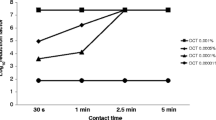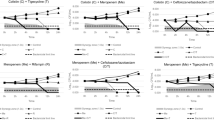Abstract
Cation-dependent inhibition of antimicrobial activity was reported for polymyxin antibiotics. Ca2+ and Mg2+ concentrations recommended by the Clinical and Laboratory Standards Institute (CLSI) for the supplementation of Müller–Hinton broth (MHB) are markedly lower than interstitial space fluid (ISF) concentrations in vivo. Hence, it was speculated that the antimicrobial activity of colistin might be overestimated if tested using conventional cation-adjusted MHB. The antimicrobial activity of colistin against n = 100 clinical isolates of Pseudomonas aeruginosa, Acinetobacter baumannii, Klebsiella pneumoniae and Escherichia coli (n = 25 each) was evaluated by broth microdilution and, for selected isolates, by time–kill curves, in MHB without cations (MHBONLY), MHB supplemented with 25 mg/L Ca2+ and 12.5 mg/L Mg2+ according to CLSI recommendations (MHBCLSI), and in MHB adjusted to 50 mg/L Ca2+ and 20 mg/L Mg2+ simulating ISF concentrations (MHBISF). The minimum inhibitory concentration (MIC) values of colistin against the vast majority of isolates of both P. aeruginosa and A. baumannii increased significantly with higher cation concentrations. The susceptibility of K. pneumoniae isolates to colistin did not show significant changes between cation-supplemented media, while the MICs of E. coli decreased with ascending cation concentrations. These findings were confirmed in time–kill studies, where colistin killing against P. aeruginosa 1514 and A. baumannii 1485 declined with increasing cation concentrations. Contrarily, the killing of selected concentrations of colistin against K. pneumoniae 15 and E. coli 16 was enhanced in the presence of increasing cation concentrations. The present data suggest that the clinical antimicrobial activity of colistin might be misestimated in vitro if tested in conventional growth media.


Similar content being viewed by others
References
Li J, Nation RL, Milne RW, Turnidge JD, Coulthard K (2005) Evaluation of colistin as an agent against multi-resistant Gram-negative bacteria. Int J Antimicrob Agents 25(1):11–25. doi:10.1016/j.ijantimicag.2004.10.001
Chen CC, Feingold DS (1972) Locus of divalent cation inhibition of the bactericidal action of polymyxin B. Antimicrob Agents Chemother 2(5):331–335
Davis SD, Iannetta A, Wedgwood RJ (1971) Activity of colistin against pseudomonas aeruginosa: inhibition by calcium. J Infect Dis 124(6):610–612
Newton BA (1953) Reversal of the antibacterial activity of polymyxin by divalent cations. Nature 172(4369):160–161
Clinical and Laboratory Standards Institute (CLSI) (2014) Performance standards for antimicrobial susceptibility testing; Twenty-fourth informational supplement. CLSI document M100-S24. CLSI, Wayne, PA
Clinical Institute of Medical and Chemical Laboratory Diagnostics, Medical University of Vienna (2014) Parameter catalogue, reference values. Home page at: http://www.kimcl.at
Karvanen M, Malmberg C, Mohamad A, Lagerbäck P, Friberg LE, Cars O (2011) Colistin is extensively lost during normal experimental conditions. Paper presented at the 51st Interscience Conference on Antimicrobial Agents and Chemotherapy (ICAAC), Chicago, IL, September 2011
Albur M, Noel A, Bowker K, Macgowan A (2014) Colistin susceptibility testing: time for a review. J Antimicrob Chemother 69(5):1432–1434. doi:10.1093/jac/dkt503
Sader HS, Rhomberg PR, Flamm RK, Jones RN (2012) Use of a surfactant (polysorbate 80) to improve MIC susceptibility testing results for polymyxin B and colistin. Diagn Microbiol Infect Dis 74(4):412–414. doi:10.1016/j.diagmicrobio.2012.08.025
Hindler JA, Humphries RM (2013) Colistin MIC variability by method for contemporary clinical isolates of multidrug-resistant Gram-negative bacilli. J Clin Microbiol 51(6):1678–1684. doi:10.1128/JCM.03385-12
Conflict of interest
Peter Matzneller declares that he has no conflict of interest.
Sabine Strommer declares that she has no conflict of interest.
Zoe Österreicher declares that she has no conflict of interest.
Dieter Mitteregger declares that he has no conflict of interest.
Markus Zeitlinger declares that he has no conflict of interest.
Compliance with ethical requirements
This article does not contain any studies with human or animal subjects.
Author information
Authors and Affiliations
Corresponding author
Rights and permissions
About this article
Cite this article
Matzneller, P., Strommer, S., Österreicher, Z. et al. Target site antimicrobial activity of colistin might be misestimated if tested in conventional growth media. Eur J Clin Microbiol Infect Dis 34, 1989–1994 (2015). https://doi.org/10.1007/s10096-015-2441-7
Received:
Accepted:
Published:
Issue Date:
DOI: https://doi.org/10.1007/s10096-015-2441-7




